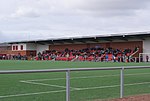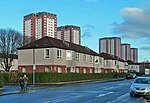Springburn railway station serves the Springburn district of Glasgow, Scotland. The station is 1+1⁄4 miles (2.0 km) north of Glasgow Queen Street (High level) station on the Cumbernauld Line and is a terminus of the Springburn branch, a spur from Bellgrove station, on the North Clyde Line.
The station was first built by the City of Glasgow Union Railway, whose branch line from Bellgrove opened to goods traffic in 1875. A station building was designed by the engineer James Carswell in 1875 and was opened in 1887, when passenger traffic then began operating. Initially built as a terminus, two through platforms were added shortly afterwards by the company when they gained running powers over the Sighthill Branch of the Edinburgh and Glasgow Railway, which ran alongside the CGUR at this location. The link into this line gave the company access to both the E&G main line at Cowlairs and also the former Garnkirk and Glasgow Railway, which had now become the main Caledonian Railway route from Glasgow Buchanan Street to NE Scotland via Cumbernauld and Stirling. Several different passenger routes operated from the station, including workers trains to Singer on the Glasgow, Dumbarton and Helensburgh Railway and a circular service that also used the Stobcross Railway and the GD&HR. The CGUR was absorbed jointly by the North British and Glasgow and South Western Railway in 1896, with the former company taking over the Bellgrove to Springburn branch.The line from Bellgrove was electrified in November 1960 as part of the North Clyde scheme, but regular services northward to Cowlairs ended in 1963, when the workers trains to Singer were withdrawn. However, three years later, trains from Cumbernauld were re-routed here with the closure of the Buchanan Street terminus to passenger traffic. Passengers had to change onto the North Clyde Line at Springburn to reach the city, as there was no direct route at that time to Queen Street main line station. Normal practice therefore was to operate a Cumbernauld to Springburn shuttle service which connected with the North Clyde line trains. Through running eventually commenced in 1989, albeit with a reversal in a loop alongside the carriage sidings and depot at Eastfield to begin with.
Cumbernauld Line trains are now able to run directly to Queen Street High Level via the Cowlairs Chord - a single track south to east curve which was opened in 1993 by British Rail. The line has now been electrified as part of the Edinburgh to Glasgow Improvement Programme.Springburn station has kept its four platforms, with two used by through trains and the others by terminating services from Bellgrove and points west. Two through goods lines used to run past the station to the west; these formed the original E&G Sighthill branch. They were latterly used to access the goods yard at Sighthill prior to its closure in October 1981, as well as to access St. Rollox railway works but they have since been lifted.The station building was designed by James Carsewell - it is now protected as a category B listed building.






